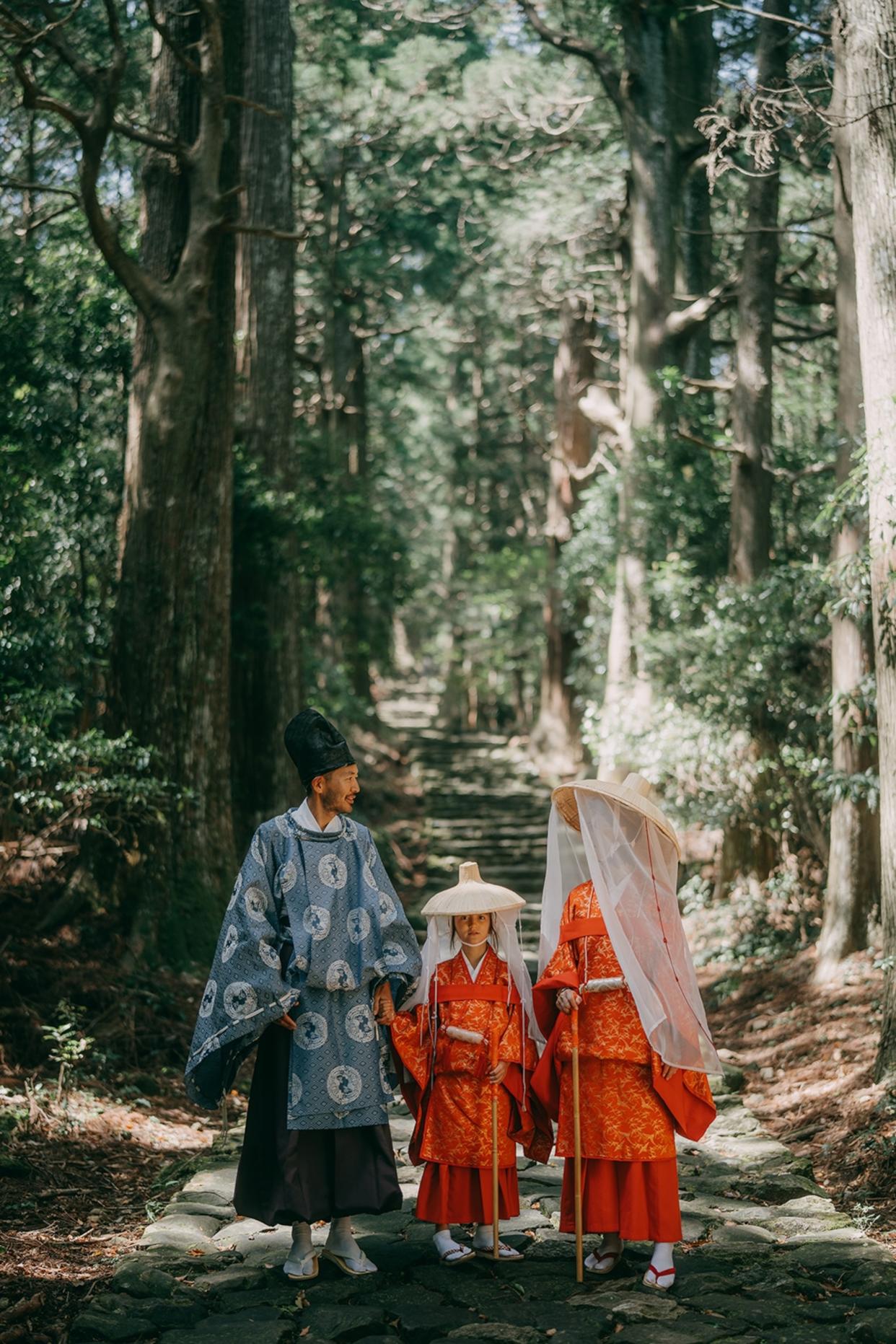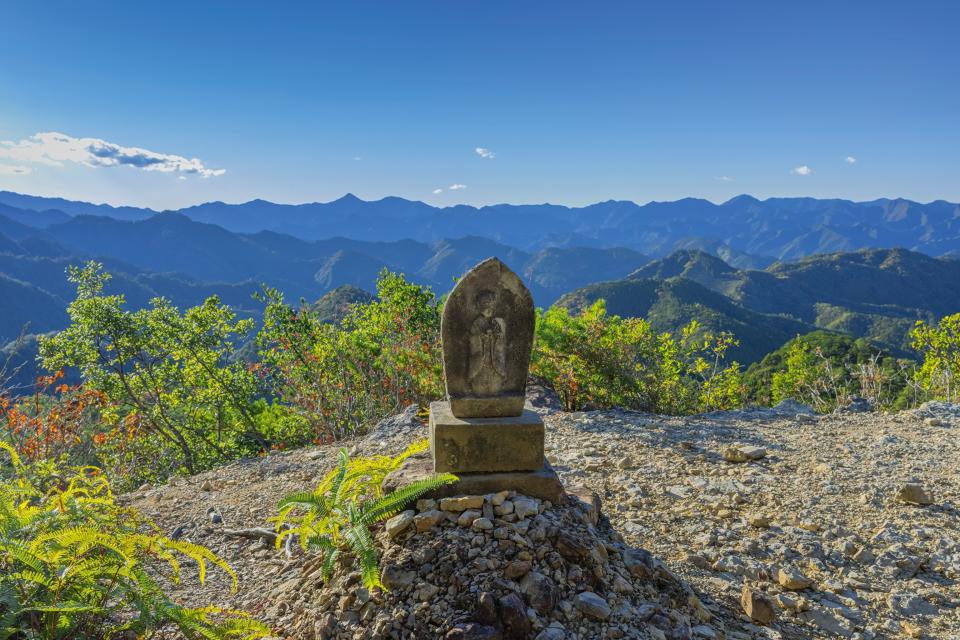
This article was produced by National Geographic Traveller (UK).
In the hazy mid-morning sun, dappled light dances across the dank woodland soil as the tips of gangly black pines sway gently in the breeze. A crisp waft of vanilla drifts in and an elusive Japanese bush warbler makes its nasally breeding call from above, just as my guide Hatsumi Sato exclaims, “Komorebi!”
“Komorebi!” she repeats with delight, doffing her traditional conical-shaped hat as we tiptoe around the puddled path. “It’s a Japanese saying for the light and shadows that pierce through the trees in low sun,” she explains, visibly moved by the conditions.
I’m hiking part of the fabled Kumano Kodo, a network of six pilgrimage routes that zigzag across the mountainous Kii Peninsula in southern Honshu. It’s one of just two pilgrimage routes to be designated a World Heritage Site by UNESCO — the other being the Camino de Santiago in Spain — and this year marks the 20th anniversary of its listing. Its well-trodden forest paths have remained largely unchanged for more than 1,000 years.
“This is the world’s only sacred location where two religions coexist in perfect harmony,” claims Hatsumi, a seasoned Kumano Kodo host, as she pauses on the narrow forest path to unfurl a comically large map. She excitedly points out the end of the Kumano Nakahechi route on the map, some 36 miles away. “The Shinto shrine Kumano Nachi Taisha is further along, and it sits beside the famous three-storied red pagoda at the Seiganto-ji Buddhist temple. Where else would this happen?”

More than 1,200 years of Shinto and Buddhist history are documented in these mountains — which is partly why the Kumano Kodo was awarded World Heritage status. We’re walking a chunk of its most popular route, the Nakahechi, which in full would take around three days to complete. It encompasses the three main shrines — Kumano Hongu Taisha, Kumano Hayatama Taisha and Kumano Nachi Taisha — known collectively as Kumano Sanzan.
Despite the route’s popularity, it had just been us earlier that morning at the starting point for the walk, a shrine called Hosshinmon-oji, whose name translates as ‘spiritual awakening gate’. It’s one of 99 smaller shrines along the Kumano Kodo that are said to house the offspring of the Kumano gods — Shinto and Buddhist spirits embodied in natural elements, such as waterfalls and trees — and walking below its rustic wooden torii gate is considered to offer a spiritual rebirth. I passed through and bowed, before performing a simple worship process at the small red shrine ahead of me. As Hatsumi taught me: bow slightly, rattle the bell outside the shrine and bow again, bow two times more deeply, clap hands slowly, and bow once more. “You’ve followed in the footsteps of many before you, including the current emperor,” Hatsumi said at the time. Did I feel reborn? Not exactly, but there was time.
Further along the trail, we pass through four miles of forest and find farming villages of traditional minka homes — Japanese wooden farmhouses — flanked by rolling hills of orchards, herb gardens and tea plantations. Silhouetted to the north are the Kii Mountains, a jagged, vegetated range separating us from the sacred Buddhist community of Koyasan, part of the same UNESCO listing as Kumano.

My hike along the trail has exacerbated some lower-back pain, so Hatsumi makes a point of stopping in front of Koshi-ita Jizo — one of many small stone statues beside the path depicting the Buddhist figure Jizo, often swathed in moss and dressed in tiny red woolly hats and scarves. “Jizo are the guardian deities of children and weary travellers. They heal pilgrims and are made out of stone for a closer connection to the Earth,” she explains, pointing to a small bundle of coins left at the statue’s feet as donations. Koshi-ita Jizo is said to heal hip and back pain, so I place a five-yen coin underneath its body before we move on.
We eventually arrive at Kumano Hongu Taisha along with a dozen other weary pilgrims holding hiking poles and trail maps. They are congregating beside a centuries-old cedar tree with a blanket of scribbled leaves at its base. “This is known as the postcard tree,” says Hatsumi, as she rummages around her bag.
She tells me the early pilgrims would write prayers on leaves here and leave them to decompose, as another connection to the Earth. Over time, the story inspired other hikers to leave their own natural ‘postcards’. Now it’s my turn, says Hatsumi, passing me a cocktail stick to stencil a message onto a thick, waxy leaf I pluck from the forest floor, before placing it with the others. My back pain subsides as we both wash our hands and mouth to enter the shrine. Perhaps I am reborn, after all.
Published in the September 2024 issue of National Geographic Traveller (UK).
To subscribe to National Geographic Traveller (UK) magazine click here. (Available in select countries only).
EMEA Tribune is not involved in this news article, it is taken from our partners and or from the News Agencies. Copyright and Credit go to the News Agencies, email news@emeatribune.com Follow our WhatsApp verified Channel





